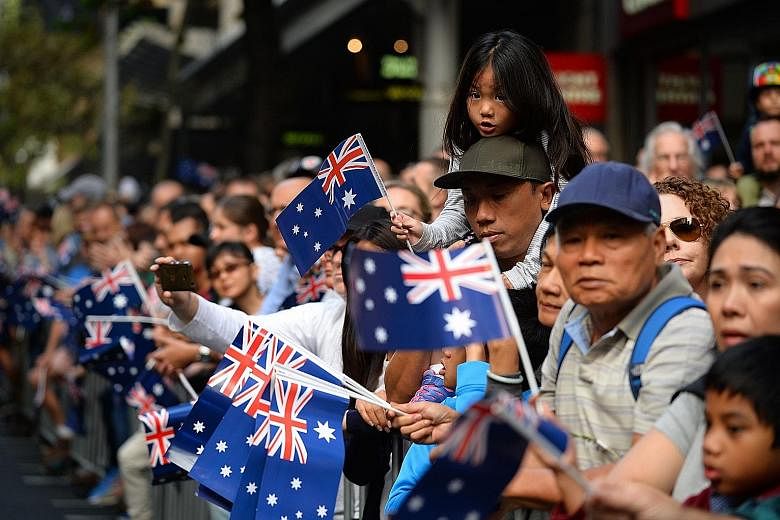A five-yearly survey in Australia has found that the face of the nation has become increasingly Asian - and perhaps the most welcome result was that nobody seemed to mind.
According to newly released data from Australia's census for last year, the country has, for the first time, more foreign-born residents from Asia than from Europe.
By country, among the top five places of birth outside Australia were England, with 907,570 people, and New Zealand, with 518,466, but Asian nations are fast catching up.
As of Aug 9 last year, when the census was conducted, there were 509,555 people who were born in China, 455,389 in India, and 232,386 in the Philippines.
The census, a snapshot of the nation taken every five years, was conducted by the Australian Bureau of Statistics (ABS) from some 10 million dwellings. The data is being released in stages through the year.
The second stage, released late last month, included information on the heritage and backgrounds of the country's 24.4 million people.
Analysis of the data is continuing, but has already revealed the dramatic demographic impact of the rapid influx of migrants from Asia in recent years, especially China and India.
-
FEWER AUSTRALIANS BORN IN AUSTRALIA
-
PROPORTION OF AUSTRALIANS BORN IN AUSTRALIA: 66.7 per cent, down from 88.2 per cent in 2001
MAIN COUNTRIES OF BIRTH OUTSIDE AUSTRALIA: England (14.7 per cent), New Zealand (8.4 per cent), China (8.3 per cent, up from 6 per cent), India (7.4 per cent, up from 5.6 per cent) and the Philippines (3.8 per cent).
AVERAGE AGE: 38, up from 28 in 1966
MAIN RELIGIONS: Christianity (52 per cent), no religion (30 per cent, up from 16 per cent in 2001), Islam (2.6 per cent) and Buddhism (2.4 per cent)
MAIN LANGUAGES SPOKEN AT HOME: English (72.7 per cent), Mandarin (2.5 per cent), Arabic (1.4 per cent), Vietnamese and Cantonese (each 1.2 per cent)
Source: Australian Bureau of Statistics
Notably, the largest Australian city Sydney now has more migrants from China than England. Of the city's 4.8 million people, 4.7 per cent are Chinese-born and 3.1 per cent were born in England.
Mass migration - mainly involving skilled workers and their families - has turned Australia into one of the world's most multicultural countries. Since 2011, more than a million migrants have arrived, including 191,000 from China and 163,000 from India.
Perhaps one of the most welcome responses from the findings was that they were greeted with little fuss. During the 1980s and 1990s, the extent of Asian immigration was the subject of heated public debate but it now appears that such concerns are dying, if not dead.
Even Sydney's Daily Telegraph, a tabloid which tends to take a hard line towards asylum seekers, noted in an editorial that the Asian demographic shift has "impressively… occurred with barely any social dislocation or disruption".
"This is a very welcome outcome - and it is as much due to the hard work of integration undertaken by Sydney's Asian communities as it is to Sydney's innate embrace of diversity," the newspaper observed.
According to the ABS, Australia has a higher proportion of overseas-born people at 26 per cent compared with New Zealand with 23 per cent, Canada (22 per cent), the United States (14 per cent), and the United Kingdom (13 per cent).
(About 7 per cent of those polled did not state their country of birth on the census form.)
Mass migration has its critics, particularly those who believe the population of Australia's biggest cities such as Sydney and Melbourne has risen too quickly, leading to growing congestion and urban sprawl.
But criticism of the predominantly Asian backgrounds of migrants has moved to the outer fringes of political debate in recent decades. Mr John Howard, when he was opposition leader, had called for a slowdown of Asian immigration in 1988. However, after he became prime minister in 1996, he oversaw increases in migration.
More recently, the anti-immigration cause has been led by right- wing firebrand Pauline Hanson, who famously declared in 1996 that Australia was at risk of "being swamped by Asians". But she has since shifted from raging against Asian immigration to raging against Muslim immigration.
Still, Australia is not immune to displays of racism and xenophobia. There has been hostility towards Chinese investment, particularly over concerns that it is making property prices less affordable.
But, for the most part, Australians increasingly appear to respond to the Asian influx with their trademark apathy.
The changes are set to continue, with Chinese and Indians by far the biggest source of migrants - together making up almost a third of the national intake in recent years.
In addition, as The Australian newspaper noted, Asian migrants - whose average age is 35 - are far younger than migrants from Europe, whose average age is 59.
"The Asian migration boom has drawn a line across the great European movement in the middle of the last century," the newspaper's social affairs commentator, Mr Rick Morton, wrote on June 28.
"Japanese migrants have tapered off… while Italians and Greeks, who helped build Australia in the 1950s and 60s with 100,000 arrivals, fell off sharply from 2006," he said. "The new wave is remaking Australia for another century."

